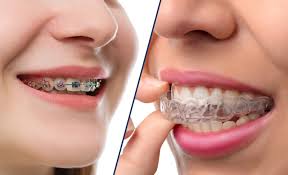
Invisalign vs Traditional Braces: Which Suits You Best?
When it comes to straightening teeth, one of the most common questions people ask is — “Invisalign vs Traditional Braces: Which suits me best?” Both treatments are effective in aligning teeth, correcting bite issues, and improving overall oral health. However, they differ in appearance, comfort, maintenance, and treatment duration. Understanding these differences can help you make an informed decision for your dental journey.
Choosing between Invisalign vs Traditional Braces can be challenging when you’re aiming for a perfect smile. Both treatments effectively straighten teeth, but they differ in appearance, comfort, and lifestyle impact. Understanding the pros and cons of Invisalign vs Traditional Braces helps you make an informed decision that fits your needs and confidence goals.
What Are Traditional Braces?
Traditional braces are metal brackets and wires that gradually move teeth into the desired position. They have been used for decades and remain a reliable solution for various orthodontic problems, including severe crowding, overbites, and underbites.
Advantages of Traditional Braces:
Highly effective for complex dental issues
Suitable for all age groups
Constant (non-removable), ensuring continuous progress
Often more affordable than Invisalign
Disadvantages:
Visible metal brackets can affect appearance
Difficult to clean around brackets and wires
May cause discomfort or mouth irritation
Food restrictions (avoid sticky and hard foods)
What Is Invisalign?
Invisalign is a modern orthodontic treatment that uses clear, removable aligners to gradually move teeth. These aligners are custom-made for each patient and changed every few weeks as teeth shift.
Advantages of Invisalign:
Nearly invisible — perfect for those who want a discreet treatment
Comfortable and smooth — no metal wires or brackets
Easy to remove for eating, brushing, and flossing
Fewer dental visits compared to braces
Disadvantages:
May not be suitable for severe alignment issues
Requires discipline to wear aligners for 20–22 hours a day
Can be slightly more expensive than braces
Invisalign vs Traditional Braces: Key Differences
| Feature | Invisalign | Traditional Braces |
|---|---|---|
| Appearance | Clear and invisible | Visible metal brackets |
| Comfort | Smooth plastic aligners | Metal wires may cause irritation |
| Maintenance | Easy to remove and clean | Harder to clean around wires |
| Treatment Time | 12–18 months (on average) | 18–24 months (varies) |
| Cost | Usually higher | Often more affordable |
| Ideal For | Mild to moderate cases | Moderate to severe cases |
When comparing Invisalign vs Traditional Braces, your choice will depend on your dental condition, budget, and lifestyle.
Which One Suits You Best?
If you want a discreet and comfortable treatment, Invisalign may be the perfect option. It’s ideal for adults and teens who prefer an aesthetic, removable solution. However, if you have complex alignment issues or need a more budget-friendly option, traditional braces might be the better choice.
Consult your orthodontist to evaluate your specific dental needs and lifestyle preferences. They can guide you on whether Invisalign vs Traditional Braces is more effective for your case.
Choosing between Invisalign vs Traditional Braces ultimately depends on your personal goals, comfort, and the complexity of your orthodontic needs. Both treatments deliver great results — a straighter, healthier smile that boosts your confidence. With the right guidance from your dentist, you can achieve the smile you’ve always wanted.
